
|
The Not-So-Big Mama Sigma 55-200 mm lens with the TCON-17 attachment |

|
My other articles related to the |
|
As you know, I have tried the Sigma DC 55-200 mm "budget" zoom lens for the E-system cameras, and I like it, warts and all. That lens has a filter thread of 55 mm. This happens to be the size of the rear thread of my TCON-17 attachment lens, made by Olympus for their C-5050Z. Why not to try these two together, I thought. (Actually, it was John Foster who tried it before and who give me the idea, which never crossed by mind before that, being just too crazy.) And here are the results. The Not-So-Big-Mama title refers to the 600 mm EFL Big Mama, combo I've used on the Olympus E-10 and E-20. The setup described here, provides a similar lens angle, being also smaller and lighter. For more details on the TCON-17, and to see some gorgeous results it produces on the C-5050Z, see my TCON/WCON article. With five optical elements and a front diameter of 80 mm it is a serious piece of glass and I'm quite fond of it. Mounting The TCON-17 attachment screws on the Sigma lens with use of the 55 mm filter thread. Unfortunately, the TCON thread is quite shallow and made of plastic, and so is the one on the lens itself, therefore the arrangement, although not quite shabby, is not too secure either. Once the attachment is in place, I would check it from time to time so that it does not fall off by accident. |
|
Handling The attachment changes the balance of the whole camera/lens ensemble, moving the center of gravity considerably to the front. For better stability it should be supported with your left hand at least halfway along its length; unfortunately, this is impossible as all parts ahead of the zoom ring (which is just next to the camera body) rotate during focusing. As inconvenient as this may seem, it did not turn out to be a major hindrance in a few shooting sessions I've used this setup for. Take it or leave it. Optical issues and operation The TCON-17 has its front element and whole optical path wide enough not to cause any visible vignetting; it also should not show any measurable loss of light (except that caused by reflection from glass surfaces). Importantly, it will work with the base (Sigma) lens set to any focal length. It means that the combination of both becomes a 93-340 mm, F/4.0-5.6 zoom lens. The same angle of coverage would be provided by a 186-680 mm zoom mounted on a 35-mm film camera, so we are talking serious telephoto here, with all the joys and pitfalls related to very long lenses. The nagging question is that of the optical quality of the combination, mostly of sharpness and chromatic aberration. I wasn't expecting miracles here. Any optical flaws of both lenses will add up to the total. I would expect the resolution of the combination to be visibly lower than that of the Sigma lens alone. But how much more? Will the combination still be usable? Read on. The samples Here is a sample picture, taken during the same session as those showing off the Sigma 55-200 mm lens. Just remember that the 1:1 sample fragments grossly exaggerate any image flaws, as described in that article. The picture was shot from a tripod using an IR remote, aperture priority, sharpness at -2, contrast at -1, and saturation at 0, which are my regular working settings on the E-300. At the left is the full frame, reduced and resharpened, to show the relative size and location of the sample at the right. The latter is just a fragment of the original image, shown in your browser in the actual pixel size. |
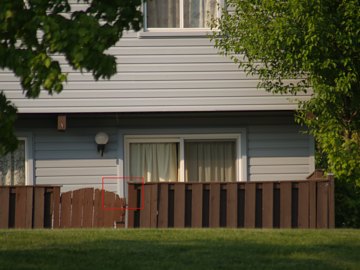
|
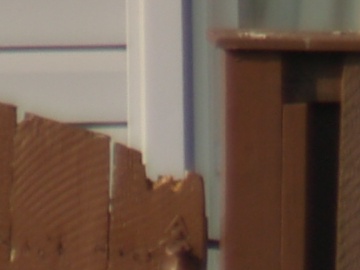
| |
| [1] E-300, Sigma 55-200mm at 200mm with TCON-17 (F = 340mm). 1/250 s at F/5.6 (wide open), ISO 100. | [2] A fragment of the same frame, shown in 1:1 pixel size without any postprocessing. |
|
The image is softer and fuzzier than those from the Sigma lens alone (see [3] below). We are, however, almost doubling the focal length, and I consider this resolution still better than nothing, i.e., shooting at 200 mm and cropping. To see what we are gaining by using TCON-17, we may compare this sample directly with one shot under the same conditions without the TCON, with the Sigma zoom at 200 mm. |
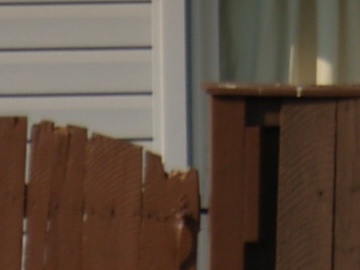
|
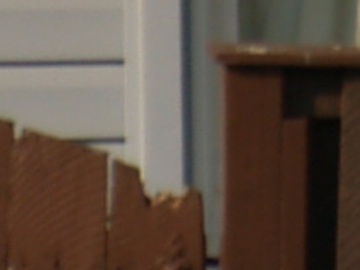
| |
| [3] Sigma 55-200mm at 200mm, without TCON-17; 1/500 s at F/5.6, ISO 100. This is the original sample... | [4] ...and here it is resized (no re-sharpening) to match the magnification of [2] above, against which it should be directly compared. |
|
Let us also remember that this comparison was made at F/5.6, the largest aperture available at 200 mm. As expected, my experimentation shows that by stepping down to F/8 (or beyond) improves the optical performance of the combination, making results printable even at 30x40 cm (12x16"). In the field Here come some pictures I shot with the Not-So-Big Mama combination, intended to check if I can use it for practical purposes, at least until I can afford to shell out seven grand for the Olympus 300/2.8 prime. Here are some, all shot without a tripod. |
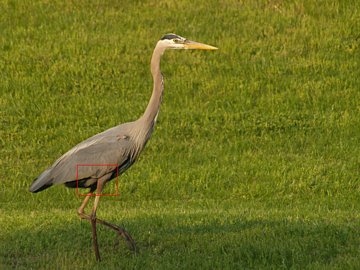
|
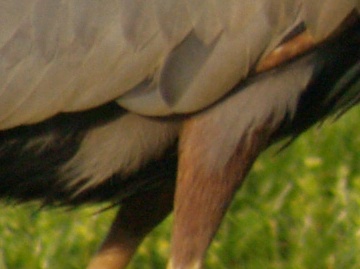
| |
| Sigma zoom at 200mm, with TCON-17: F = 340mm; program exposure (-0.3EV): 1/250 s at F/6.3, ISO 400. | ||

|

| |
| Sigma zoom at 146mm, with TCON-17: F = 248mm; program exposure (-0.3EV): 1/500 s at F/8, ISO 400. | ||
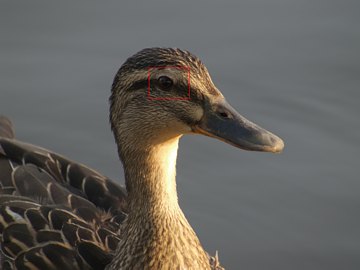
|
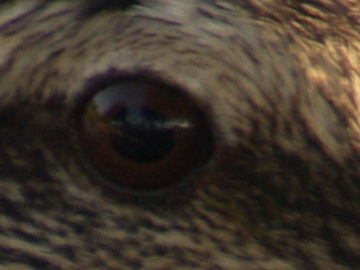
| |
| Sigma zoom at 176mm, with TCON-17: F = 299mm; aperture priority (-0.3EV): 1/60 s at F/8, ISO 200. (Full frame: here.) | ||
|
Conclusions The combination of Sigma 55-200 mm with TCON-17 performs not bad; it turned out quite usable. In most cases its performance, while no match for a decent lens, is "good enough". One has to remember that the image sharpness, a significant part of its technical quality, does not depend solely on the lens. Focusing problems, limited depth of field, camera shake, noise and other CCD effects — all this affect the final results. "Good enough" means, in my book at least, that the lens resolution and optical flaws do not become the bottleneck in the whole process. Quite often you can see pictures, shot with $200 lenses, which are as good or better than some from lenses costing ten times as much (and really excelling in terms of resolution charts or modulation transfer function) — this just means that both lenses were at least "good enough", but the other factors in the first lens amounted to less image degradation than in the second one. Besides, how much choice do we have? The whole Not-So-Big Mama setup costs you $250 or so, resulting in a zoom covering focal lengths of 93-340 mm at a F/4.0-5.6 maximum aperture. This, in terms of 35-mm film format, is equivalent to 196-680 mm. Even if it is not good enough for critical applications (and it actually may be, when stepped down to F/8 and beyond), you would be hard pressed to find an alternative; certainly not at this price. If you have the Sigma 55-200 mm lens, then spending an extra $90 for the TCON-17, even for occasional use, is a bargain. With all my complaints, the combination is quite usable, and capable of delivering presentable results. Note of 2008: Only recently did Four Thirds SLR users get a reasonably priced alternative to the Not-So-Big-Mama: the Olympus 70-300 mm F/4.0-5.6 ZD ED zoom (based on a similar Sigma lens, and possibly made by Sigma for Olympus). From my own experience, this lens delivers much better resolution than the combination described here, and it costs a reasonable $400 in the States. |

|
My other articles related to the |
|
Olympus® is a registered trademark of Olympus Corporation.
This page is not sponsored or endorsed by Olympus (or anyone else) and presents solely the views of the author. Copyright © 2005 by J. Andrzej Wrotniak |
| Home: wrotniak.net | Search this site | Change font size |
| Posted 2005/05/22; last updated 2008/06/28 | Copyright © 2005-2008 by J. Andrzej Wrotniak |